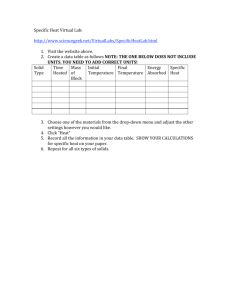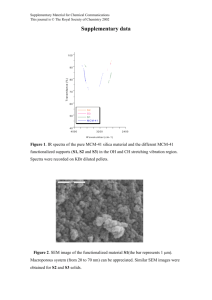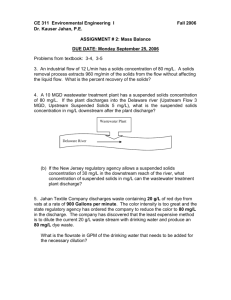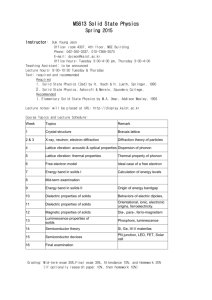Materials Balances with Reactors
advertisement
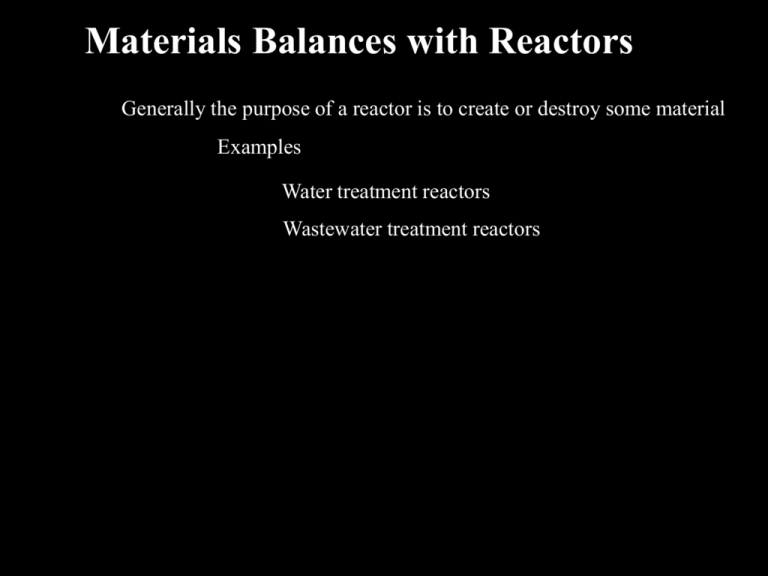
Materials Balances with Reactors Generally the purpose of a reactor is to create or destroy some material Examples Water treatment reactors Wastewater treatment reactors Examples Wastewater treatment Objective is to convert dissolved organic compounds to suspended solid material that can the be removed from the waste stream Organics are converted to microorganisms Excess organisms are wasted from the system - called waste activated sludge An activated sludge system has an influent flow of 10 mgd and a suspended solids concentration of 50 mg/L. The waste activated sludge flow rate is 0.2 mgd at a solids concentration of 1.2%. The effluent has a solids concentration of 20 mg/L. What is the rate of solids production in the system (commonly called the yield) Consider a mass balance around the whole system Mass Balance for Flow rate 0 = 10 – [0.2 + QE] + 0 QE = 9.8 mgd Mass balance on Solids Rate of Rate of Rate of Rate of = + Solids Solids Solids In Solids Out Generation accumulated 0 = (QICI) – [(QECE) + QWCW] + X X = the rate of solids production ( the rate at which organics are converted to microorganisms Units (Gallons . Mg)/(day. L) Not appropriate units for X - convert to lb/day 1,000,000gal/day x 1 mg/L x 3.78 L/gal x 10-6 kg/mg x 2.2 lb/kg = 8.34 lb/day 0 = (10)(50)(8.34) – [(9.8)(20)(8.34) – (0.2)(12,000)(8.34)] + X X = 17,438 lb/day Solids Destruction Anaerobic Digestion Pathogen Destruction Volatile Organic Destruction Gas Production CO2 and Methane Example The influent flow to a digester is 0.1 m3/s and has a solids concentration of 4%, of which 70% are volatile solids The supernatant has 2% solids of which 50% are volatile solids. The digested solids have a solids concentration of 6% (50% volatile). Find the flow rate of the supernatant and digested sludge? Three possible materials balances of concern: Volatile solids Total Solids Sludge volume Mass Balance on Volatile Solids Rate of Volatile Solids accumulated Rate of Rate of = Volatile Solids - Volatile Solids + In Out Rate of Volatile Solids Generation 0 = (Q0C0) – [(QGCG + QSCS + QDCD] - X X = the rate of volatile solids consumption Units (m3/s) (mg/L) (1000 L/m3) (1g/1000mg) = g/s 0 = (0.1)(40,000)(0.7) – [0 + QS(20,000)(0.5) + QD(60,000)(0.5)] - X 0 = 2800 – 10,000 QS – 30,000 QD - X Mass Balance on Total Solids Rate of Total Solids accumulated Rate of = Total Solids In Rate of Total Solids Out + Rate of Total Solids Generation 0 = Q0C0 – [QGCG + QSCS + QDCD] - X 0 = (0.1)(40,000) – [0 + QS(20,000) + QD(60,000)] - X Balance on Liquid Flows 0 = Q0 – [QS + QD + QG] - 0 Since there is very little liquid in the gas flow stream, QG is negligible 0 = 0.1 – QS - QD Now we have three equations, with three unknowns: 0 = 2800 – 10,000 QS – 30,000 QD - X 0 = (0.1)(40,000) – QS(20,000) - QD(60,000) - X 0 = 0.1 – QS - QD Solving: QD = 0.01 m3/s QS = 0.09 m3/s X = 1600 g volatile solids/s




